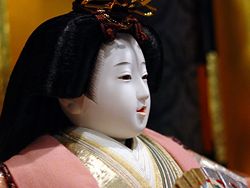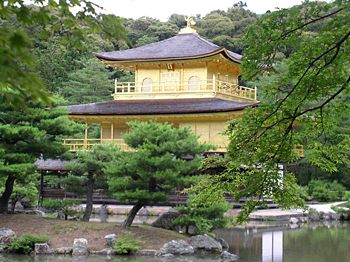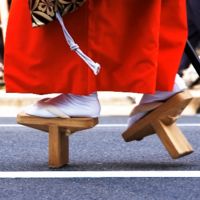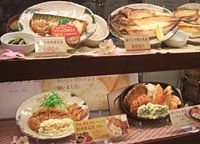Culture of Japan: Difference between revisions
imported>John Stephenson (moving refs to subpage) |
mNo edit summary |
||
| (43 intermediate revisions by 11 users not shown) | |||
| Line 1: | Line 1: | ||
{{subpages}} | {{subpages}} | ||
[[Image: | [[Image:Himeji Castle.jpg|left|thumb|400px|[[Himeji Castle]] is a UNESCO [[World Heritage site]]; its defences and gardens showcase two sides of Japan's history and culture.]] | ||
The '''culture of [[Japan]]''' has evolved greatly over the years, from the country's original [[Jomon]] culture to contemporary times, which combines influences from | The '''culture of [[Japan]]''' has evolved greatly over the years, from the country's original [[Jomon]] culture to contemporary times, which combines influences from Asia and the [[Western society|West]]. After several waves of immigration from the continent and nearby Pacific islands (see ''[[history of Japan]]''), followed by a heavy importation of [[Culture of China|Chinese culture]], the inhabitants of Japan experienced a long period of relative isolation from the outside world under the [[Tokugawa shogunate]], until the arrival of the '[[Black Ships]]' and the [[Meiji era]]. As a result, a culture distinctively different from other Asian traditions developed, and echoes of this persist in the country today, with [[Japanese popular culture]] now the mainstream. | ||
{{TOC|right}} | |||
==Language== | |||
===Japanese=== | |||
{{main|Japanese language}} | |||
The Japanese [[language (general)|language]] (日本語 ''Nihongo'') has always played a significant role in Japanese culture. Spoken mainly in Japan and by some Japanese communities around the world, it is an [[agglutinative language]] - grammatical units link together in long 'strings' to make [[word]]s. For example, 食べたくなかった ''tabetakunakatta''<ref>''Tabetakunakatta'' can be followed by です ''desu'', which is the copula verb equivalent to 'be'. ''Tabetakunakatta'', then, is not really a verb in the same way the 'eat' is a verb in English, in that it behaves somewhat like an adjective in Japanese.</ref> 'did not want to eat' is composed of the [[morphology (linguistics)|morphemes]] ''tabe''- 'eat', -''ta''- 'want', -''ku''- '[[adverb]]', -''na''- 'negative', and ''-kat-'' and ''-ta'' - both signifying that the action is complete, i.e. in the past. [[Phonology|Phonologically]], its 'sounds' consist mainly of consonant-vowel units that cannot be split up, such as ''bu'', ''ni'' and ''ka'', which are written as single symbols. | |||
The Japanese language is written with a combination of three different scripts. [[Chinese characters]] (漢字 ''[[kanji]]'') are used for the most meaningful words such as most [[noun]]s and [[verb]]s; these take some time to learn. Two further scripts, ''[[hiragana]]'' (ひらがな) and ''[[katakana]]'' (カタカナ) write [[mora]]s, equivalent to but not the same as [[syllable]]s, and to a degree can indicate [[pronunciation]]. The [[Roman alphabet]], ''[[roomaji]]'' (ローマ字), is also often used in modern Japanese. | |||
The Japanese | |||
===Ainu=== | |||
{{main|Ainu language}} | |||
The [[Ainu people|Ainu]] language ((アイヌ・イタㇰ, ''Aynu itak'') is spoken by one of Japan's [[indigenous peoples]], mainly in [[Hokkaido]]. Ainu is [[endangered language|endangered]], with few fluent speakers, but measures to maintain the language are ongoing. Historically, Ainu was an unwritten language, but it is now rendered in a modified form of the ''katakana'' script. | |||
==Popular culture== | |||
{{main|Japanese popular culture}} | |||
[[Image:United_in_different_colors.jpg|thumb|left|300px|'[[Cosplay|Cosplayers]]' (from コスプレ ''kosupure'' 'costume roleplay') - teenagers who dress as characters from [[film]], [[television]] or ''[[animé]]'' cartoons - pose for the cameras in [[Harajuku]], [[Tokyo]]. These girls are dressed as members of the Japanese band 'Dir en grey'.<BR><small>Photo © by Sonny Santos, used by [[Image_talk:Menu.jpg/Permission|permission]].</small>]] | |||
[[Image:Harajuku_Up_&_Close.jpg|thumb|right|250px|Traditional and modern meet on the streets of [[Harajuku]], [[Tokyo]].<BR><small>Photo © by Sonny Santos, used by [[Image_talk:Menu.jpg/Permission|permission]].</small>]] | |||
'''Japanese [[popular culture]]''' is a highly distinct collection of [[fashion]]s, [[art]], [[music]] and other forms of expression, appearing in both mainstream [[society]] and underground [[subculture]]s. [[Cartoon]]s, [[comic]]s and above all, anything ''kawaii'' (可愛い, 'cute') are strong influences on fashions. Baby-faced cartoons and small gadgets, often [[pink]], are perhaps the best examples of this phenomenon, and the prevalence of ''kawaii'' has led to criticism which depicts Japanese society as one of increasing [[infantilization|infantilisation]].<ref>e.g. Kerr (2002: 312).</ref> While young Japanese often follow overseas trends, they have also developed their own trendy [[subculture]]s that to outsiders may border on the bizarre - young people dressed in [[maid]] outfits or in [[Victorian]]-style '[[Lolita]]' costumes are a common sight around the country. | |||
Japan is also a nation of avid [[newspaper]] and [[magazine]] readers.<ref>''[[Yomiuri Shimbun]]'' (2008): '[http://adv.yomiuri.co.jp/m-data/english/2008_2010/newspaper6.html Japanese newspapers have stable readership]'. </ref> News reporting ranges from serious political stories to the latest celebrity gossip, with the lives of these 'idols' detailed in popular magazines as well as on-line. The biggest-selling newspaper is the ''[[Yomiuri Shimbun]]'' (読売新聞),<ref>''Yomiuri Shimbun'' (2008): '[http://adv.yomiuri.co.jp/m-data/english/2008_2010/newspaper6.html Japanese newspapers have stable readership]'. </ref> while one of most widely read fashion magazines is ''FRUiTS''.<ref>[http://www.fruits-mg.com/xnew/e/index.html STREET/FRUiTS/TUNE] - official English website.</ref> | |||
==Visual arts== | ==Visual arts== | ||
{{main|Japanese art}} | {{main|Japanese visual art}} | ||
=== | ===Painting, calligraphy and woodblock prints=== | ||
{{ | {{seealso|Japanese painting|Japanese calligraphy|Ukiyo-e}} | ||
Some of the most traditional Japanese art involves representations in paint, [[woodblock prints]] and careful rendering of Japanese text. [[Painting]], such as ''sumie'' (墨絵, '[[wash painting]]'), has been an art in Japan for a very long time: the [[paintbrush|brush]] is a traditional [[written language|writing]] tool, and the extension of that to its use as an artist's tool was probably natural, hence [[calligraphy]]; as in other [[East Asia]]n countries, the rendering of text itself is seen as a traditional art form as well as a means of conveying information. The art can consist of phrases, [[poetry|poems]], stories, or even single [[Kanji|characters]]. The style and format of the writing can mimic the subject matter, even to the point of texture and stroke speed. The creation of the calligraphy is considered as much an art as the pictures themselves, and it can take over one hundred acts of mimicry to produce the desired effect of a single character. | |||
''Ukiyo-e'' (浮世絵, literally 'pictures of the floating world') is a genre of [[Woodblock printing in Japan|woodblock prints]] that exemplifies the characteristics of pre-[[Meiji]] Japanese art. Because these prints could be mass-produced, they were available to a wide cross-section of the Japanese populace — those not wealthy enough to afford original paintings — during their heyday, from the [[seventeenth century|seventeenth]] to the [[twentieth century|twentieth]] century. The widespread popularity of ''ukiyoe'' prints lead to their recognition as a very Japanese art form, which in turn has led to significant modern mimicry of ''ukiyoe'' in advertisements, posters, and other art including ''[[manga]]'' comics. | |||
===Sculpture=== | ===Sculpture and flower arranging=== | ||
{{ | {{seealso|Japanese sculpture|Ikebana}} | ||
[[sculpture]] and [[flower arranging]] (活花, ''ikebana''). [[Wood]], often [[lacquer]]ed, [[gild]]ed, or brightly painted, is the most common traditional sculpting material, but [[bronze]] and other [[metal]]s are also important. ''Ikebana'' is more widely known outside Japan for its focus on harmony, colour use, rhythm, and elegantly simple design. It is an art centred greatly on expressing the [[season]]s, and is meant to act as a [[symbol]] to something greater than the [[flower]] itself. | |||
=== | ===Dolls=== | ||
{{main| | {{main|Japanese dolls}} | ||
'' | {{Image|Japanese-doll.jpg|left|250px|A traditional Japanese [[doll]].}} | ||
Japanese [[doll]]s (雛人形 ''hina ningyoo'') are highly significant, with dollmaking a long-standing tradition. The most important time of year is the 3rd March Doll Festival (雛祭り ''Hina Matsuri''), also known as Girls' Day, when families put out on display a range of elaborately-garbed dolls to ensure girls' future happiness. Homes and shops put up traditionally-clothed dolls of various sizes, set on a red dais. These feature the emperor and empress, attended by a court retinue. | |||
The | The traditional belief that dolls can absorb harmful spirits is represented in modern Japan at [[Iwatsuki]] (岩槻区 ''Iwatsuki-ku''), a centre of dollmaking. A ceremony held in November allows the owners of dolls that have soaked up bad spirits to purify them. 29th April sees another ceremony at Iwatsuki, ''Nagashi-Bina'' (流し雛 'floating dolls'), where people cast away paper dolls onto the river, using little boats into which is also placed paper on which wishes for the future are written. This also takes place on 3rd March elsewhere in Japan. | ||
==Performing arts== | ==Performing arts== | ||
| Line 42: | Line 46: | ||
'''Mention Kabuki, Noh, Takurazuka, and Bunraku.''' | '''Mention Kabuki, Noh, Takurazuka, and Bunraku.''' | ||
==Architecture== | == Architecture == | ||
{{main|Japanese architecture}} | {{main|Japanese architecture}} | ||
{{Image|Golden Pavilion, Kyoto.JPG|left|350px|''Kinkaku-ji'' (金閣寺 or 'Golden Pavilion') is a Zen temple in Kyoto.}} | |||
Japanese architecture has as long a history as any other aspect of Japanese culture. Originally heavily influenced by [[Chinese architecture]], it also develops many differences and aspects which are indigenous to Japan. Examples of traditional architecture are seen at [[Buddhist temple (Japan)|Temples]], [[Jinja (Shinto)|Shinto shrines]] and [[Japanese castle|castles]] in [[Kyoto]] and [[Nara]]. Some of these buildings are usually constructed with [[Japanese garden|traditional gardens]], which are influenced from [[Zen]] ideas. | Japanese architecture has as long a history as any other aspect of Japanese culture. Originally heavily influenced by [[Chinese architecture]], it also develops many differences and aspects which are indigenous to Japan. Examples of traditional architecture are seen at [[Buddhist temple (Japan)|Temples]], [[Jinja (Shinto)|Shinto shrines]] and [[Japanese castle|castles]] in [[Kyoto]] and [[Nara]]. Some of these buildings are usually constructed with [[Japanese garden|traditional gardens]], which are influenced from [[Zen]] ideas. | ||
Some modern architects, such as [[Yoshio Taniguchi]] and [[Tadao Ando]] are known for their amalgamation of two different ideas, Japanese traditional architecture and Western one. | Some modern architects, such as [[Yoshio Taniguchi]] and [[Tadao Ando]] are known for their amalgamation of two different ideas, Japanese traditional architecture and Western one. | ||
==Clothing== | == Clothing == | ||
{{seealso|Geta}} | {{seealso|Geta}} | ||
[[Image:tengu-geta.jpg|thumb|right|200px|''Tengu-[[geta]]'' shoes may be worn in traditional festivals.<BR><small>Photo © by Sonny Santos, used by [[Image_talk:tengu-geta.jpg/Permission|permission]].</small>]] | [[Image:tengu-geta.jpg|thumb|right|200px|''Tengu-[[geta]]'' shoes may be worn in traditional festivals.<BR><small>Photo © by Sonny Santos, used by [[Image_talk:tengu-geta.jpg/Permission|permission]].</small>]] | ||
The Japanese word ''[[kimono]]''(着物) means 'something one wears'; it is a traditional garment of Japan. Originally, the word ''kimono'' was used for all types of clothing, but eventually, it came to refer specifically to the full-length garment also known as the ''[[nagagi]]'', meaning 'long-wear', that is still worn today on special occasions by women, men, and children. It is often known as ''[[wafuku]]'', which means 'Japanese clothes'. Kimono come in a variety of colours, styles, and sizes. Men mainly wear darker or more muted colours, while women tend to wear brighter colours and [[pastels]], and often with complicated abstract or floral patterns. The summer kimono, which are lighter, are called ''[[yukata]]''. Formal kimono are typically worn in several layers, with number of layers, visibility of layers, sleeve length, and choice of pattern dictated by social status and the occasion for which the kimono is worn. | The Japanese word ''[[kimono]]'' (着物) means 'something one wears'; it is a traditional garment of Japan. Originally, the word ''kimono'' was used for all types of clothing, but eventually, it came to refer specifically to the full-length garment also known as the ''[[nagagi]]'', meaning 'long-wear', that is still worn today on special occasions by women, men, and children. It is often known as ''[[wafuku]]'', which means 'Japanese clothes'. Kimono come in a variety of colours, styles, and sizes. Men mainly wear darker or more muted colours, while women tend to wear brighter colours and [[pastels]], and often with complicated abstract or floral patterns. The summer kimono, which are lighter, are called ''[[yukata]]''. Formal kimono are typically worn in several layers, with number of layers, visibility of layers, sleeve length, and choice of pattern dictated by social status and the occasion for which the kimono is worn. | ||
==Cuisine== | ==Cuisine== | ||
[[Image:Japanese-restaurant-window.jpg|left|thumb|200px|Japanese restaurants often display plastic replicas of many dishes, so diners can see exactly what to expect.]] | |||
{{main|Japanese cuisine}} | {{main|Japanese cuisine}} | ||
Japanese food is highly seasonal and regionalised; typically, a town or city will be well-known for a particular food or a specific way of serving it. For example, ''udon'' (饂飩 'thick wheat [[noodles]]') will be eaten hot in the winter months, and cold in the summer; and the thickness of the udon varies by region, as do the toppings added to the basic bowl of noodles. ''Sanuki'' (讃岐) udon from [[Kagawa prefecture]] is very popular, for instance; this kind of udon is thicker than others. By contrast, ''kishimen'' (棊子麺) udon from the [[Nagoya]] area is flatter. Around [[Osaka]], ''aburaage'' (油揚げ 'fried [[tofu]]') is eaten with udon. | |||
== | Japanese rice (ご飯 ''gohan'') is commonly eaten either from a separate bowl, or incorporated into a particular dish, for example as a base for pork cutlets (カツ丼 ''katsudon'') [[Sushi]] (鮨) is actually vinegared rice with meat or vegetables, served raw; raw fish is ''sashimi'' (刺身), sliced very thinly. Other raw meat can be similarly sliced: in [[Kyushu]], for example, ''basashi'' (馬刺し 'raw [[horse]] meat') is served in this way. | ||
As elsewhere in Asia, most of the food is served all at once, rather than in separate courses, and it is acceptable to eat from several bowls, a little at a time. In many meals [[miso soup]] (御味御付 ''omiotsuke'', made from [[soybean]] paste) also appears. Meat is a staple of the Japanese diet: fish and red or white meat are usually found in a typical meal. [[Chopsticks]] are used to eat most foods, but forks or spoons may appear for some dishes. | |||
== Sport == | |||
{{main|Sport in Japan}} | {{main|Sport in Japan}} | ||
The most popular sport in Japan is [[baseball]]; annual attendance is around 200 million per year. Though [[association football|football]] has become more popular in recent years, it remains that more Japanese bought tickets for baseball games than to watch [[World Cup (football)|World Cup]] matches when Japan staged the event in 2002.<ref>''Japan Times'': '[http://search.japantimes.co.jp/cgi-bin/sb20020705a2.html It may be the world's most popular sport, but not here in Japan]'. 5th July 2002.</ref> | |||
Many other foreign-rooted sports are popular in Japan, such as [[table tennis]], [[tennis]], [[volleyball]], [[basketball]], [[golf]], and [[rugby]]. | |||
== Martial arts == | |||
{{main|Japanese martial arts}} | |||
[[Martial arts]] are popular in Japan, especially Japanese ones; they may combine elements of competitive sport with self-defence, fitness training and spectacle, and many Japanese train in, compete in and watch these along with [[combat sports]]. The best-known Japanese martial arts [[sport]] outside the country is ''[[sumo wrestling|sumō]]'' (相撲) [[wrestling]], which includes elements of the local ''[[Shinto|Shintō]]'' (神道) religion. Other Japanese martial arts include ''[[judo|jūdō]]'' (柔道, 'gentle way'), ''[[karate]]'' (空手, 'empty hand'), ''[[aikido|aikidō]]'' (合気道, 'way of harmony') and ''[[kendo|kendō]]'' (剣道, 'way of the [[sword]]'). Judo is perhaps the most popular, as high schools and universities have teams for interscholastic competition. | |||
Some martial arts, such as aikido, ''[[Iaido|iaidō]]'' (居合道, 'way of drawing the [[sword]]') and ''[[kenjutsu]]'' (剣術, '[[fencing]]') are practiced almost solely for non-competitive reasons. Some martial arts also play a [[spirituality|spiritual]] or religious role in Japan. ''[[Kyudo|Kyūdō]]'' (弓道, 'way of the [[bow (archery)|bow]]'), or Japanese [[archery]], has become related to and involved in the study of [[Zen Buddhism]]. Aikido is considered in Japan to be a religion and [[philosophy]] as well as a martial art. | |||
[[Mixed martial arts]] and similar combat sports have also become popular in Japan in the past few decades, with the most well-known example being the mixed martial arts organisation known as the [[Pride Fighting Championships]]. [[Shooto]] (修斗 ''shūto'' 'learn [[combat]]') as a sport has been popular, with techniques derived from [[shoot wrestling]]. Professional [[wrestling]], or ''[[Professional wrestling in Japan|puroresu]]'' (プロレス), is also popular, although this is technically not a combat sport as such events are typically '[[work (professional wrestling)|work]]s' (staged) and not true competitions. | |||
==== Martial arts in popular culture ==== | |||
Japanese entertainment has many references to martial arts. Traditional [[Theatre in Japan|Japanese theatre]] and [[Literature in Japan|literature]] include stories like ''[[The 47 Ronin]]'' and works such as ''[[The Book of Five Rings]]'' and ''[[Hagakure]]'' (葉隱, 'In the Shadow of Leaves', also known as ''The Book of the [[Samurai]]''). [[Film in Japan|Japanese films]] often have martial artists as characters or martial arts as the theme, such as in [[samurai film]]s like ''[[The Seven Samurai]]''. In popular culture, ''[[Anime]]'' and ''[[manga]]'' often heavily feature characters trained in (usually highly stylised) martial arts, as in ''[[Dragon Ball Z]]'', ''[[Samurai Champloo]]'', and ''[[Naruto]]''. | |||
==Footnotes== | ==Footnotes== | ||
{{reflist|2}} | |||
==See also== | ==See also== | ||
*[[Japan]] | *[[Japan]] | ||
*[[History of Japan]] | |||
*[[Japan/Gallery|Japan - Gallery]] | *[[Japan/Gallery|Japan - Gallery]] | ||
*[[Japanese language]] | *[[Japanese language]] | ||
*[[Japanese English]] | *[[Japanese English]] | ||
*[[Japanese media]] | |||
*[[Judo]] | |||
*[[Aikido]] | |||
*[[Geta]] | *[[Geta]] | ||
*[[Korea and Japan]][[Category:Suggestion Bot Tag]] | |||
[[ | |||
[[Category: | |||
Latest revision as of 12:01, 3 August 2024

The culture of Japan has evolved greatly over the years, from the country's original Jomon culture to contemporary times, which combines influences from Asia and the West. After several waves of immigration from the continent and nearby Pacific islands (see history of Japan), followed by a heavy importation of Chinese culture, the inhabitants of Japan experienced a long period of relative isolation from the outside world under the Tokugawa shogunate, until the arrival of the 'Black Ships' and the Meiji era. As a result, a culture distinctively different from other Asian traditions developed, and echoes of this persist in the country today, with Japanese popular culture now the mainstream.
Language
Japanese
The Japanese language (日本語 Nihongo) has always played a significant role in Japanese culture. Spoken mainly in Japan and by some Japanese communities around the world, it is an agglutinative language - grammatical units link together in long 'strings' to make words. For example, 食べたくなかった tabetakunakatta[1] 'did not want to eat' is composed of the morphemes tabe- 'eat', -ta- 'want', -ku- 'adverb', -na- 'negative', and -kat- and -ta - both signifying that the action is complete, i.e. in the past. Phonologically, its 'sounds' consist mainly of consonant-vowel units that cannot be split up, such as bu, ni and ka, which are written as single symbols.
The Japanese language is written with a combination of three different scripts. Chinese characters (漢字 kanji) are used for the most meaningful words such as most nouns and verbs; these take some time to learn. Two further scripts, hiragana (ひらがな) and katakana (カタカナ) write moras, equivalent to but not the same as syllables, and to a degree can indicate pronunciation. The Roman alphabet, roomaji (ローマ字), is also often used in modern Japanese.
Ainu
The Ainu language ((アイヌ・イタㇰ, Aynu itak) is spoken by one of Japan's indigenous peoples, mainly in Hokkaido. Ainu is endangered, with few fluent speakers, but measures to maintain the language are ongoing. Historically, Ainu was an unwritten language, but it is now rendered in a modified form of the katakana script.
Popular culture

Photo © by Sonny Santos, used by permission.
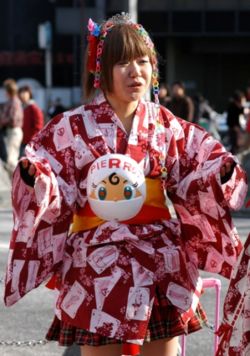
Photo © by Sonny Santos, used by permission.
Japanese popular culture is a highly distinct collection of fashions, art, music and other forms of expression, appearing in both mainstream society and underground subcultures. Cartoons, comics and above all, anything kawaii (可愛い, 'cute') are strong influences on fashions. Baby-faced cartoons and small gadgets, often pink, are perhaps the best examples of this phenomenon, and the prevalence of kawaii has led to criticism which depicts Japanese society as one of increasing infantilisation.[2] While young Japanese often follow overseas trends, they have also developed their own trendy subcultures that to outsiders may border on the bizarre - young people dressed in maid outfits or in Victorian-style 'Lolita' costumes are a common sight around the country.
Japan is also a nation of avid newspaper and magazine readers.[3] News reporting ranges from serious political stories to the latest celebrity gossip, with the lives of these 'idols' detailed in popular magazines as well as on-line. The biggest-selling newspaper is the Yomiuri Shimbun (読売新聞),[4] while one of most widely read fashion magazines is FRUiTS.[5]
Visual arts
Painting, calligraphy and woodblock prints
- See also: Japanese painting, Japanese calligraphy, and Ukiyo-e
Some of the most traditional Japanese art involves representations in paint, woodblock prints and careful rendering of Japanese text. Painting, such as sumie (墨絵, 'wash painting'), has been an art in Japan for a very long time: the brush is a traditional writing tool, and the extension of that to its use as an artist's tool was probably natural, hence calligraphy; as in other East Asian countries, the rendering of text itself is seen as a traditional art form as well as a means of conveying information. The art can consist of phrases, poems, stories, or even single characters. The style and format of the writing can mimic the subject matter, even to the point of texture and stroke speed. The creation of the calligraphy is considered as much an art as the pictures themselves, and it can take over one hundred acts of mimicry to produce the desired effect of a single character.
Ukiyo-e (浮世絵, literally 'pictures of the floating world') is a genre of woodblock prints that exemplifies the characteristics of pre-Meiji Japanese art. Because these prints could be mass-produced, they were available to a wide cross-section of the Japanese populace — those not wealthy enough to afford original paintings — during their heyday, from the seventeenth to the twentieth century. The widespread popularity of ukiyoe prints lead to their recognition as a very Japanese art form, which in turn has led to significant modern mimicry of ukiyoe in advertisements, posters, and other art including manga comics.
Sculpture and flower arranging
- See also: Japanese sculpture and Ikebana
sculpture and flower arranging (活花, ikebana). Wood, often lacquered, gilded, or brightly painted, is the most common traditional sculpting material, but bronze and other metals are also important. Ikebana is more widely known outside Japan for its focus on harmony, colour use, rhythm, and elegantly simple design. It is an art centred greatly on expressing the seasons, and is meant to act as a symbol to something greater than the flower itself.
Dolls
Japanese dolls (雛人形 hina ningyoo) are highly significant, with dollmaking a long-standing tradition. The most important time of year is the 3rd March Doll Festival (雛祭り Hina Matsuri), also known as Girls' Day, when families put out on display a range of elaborately-garbed dolls to ensure girls' future happiness. Homes and shops put up traditionally-clothed dolls of various sizes, set on a red dais. These feature the emperor and empress, attended by a court retinue.
The traditional belief that dolls can absorb harmful spirits is represented in modern Japan at Iwatsuki (岩槻区 Iwatsuki-ku), a centre of dollmaking. A ceremony held in November allows the owners of dolls that have soaked up bad spirits to purify them. 29th April sees another ceremony at Iwatsuki, Nagashi-Bina (流し雛 'floating dolls'), where people cast away paper dolls onto the river, using little boats into which is also placed paper on which wishes for the future are written. This also takes place on 3rd March elsewhere in Japan.
Performing arts
Mention Kabuki, Noh, Takurazuka, and Bunraku.
Architecture
Japanese architecture has as long a history as any other aspect of Japanese culture. Originally heavily influenced by Chinese architecture, it also develops many differences and aspects which are indigenous to Japan. Examples of traditional architecture are seen at Temples, Shinto shrines and castles in Kyoto and Nara. Some of these buildings are usually constructed with traditional gardens, which are influenced from Zen ideas.
Some modern architects, such as Yoshio Taniguchi and Tadao Ando are known for their amalgamation of two different ideas, Japanese traditional architecture and Western one.
Clothing
- See also: Geta
The Japanese word kimono (着物) means 'something one wears'; it is a traditional garment of Japan. Originally, the word kimono was used for all types of clothing, but eventually, it came to refer specifically to the full-length garment also known as the nagagi, meaning 'long-wear', that is still worn today on special occasions by women, men, and children. It is often known as wafuku, which means 'Japanese clothes'. Kimono come in a variety of colours, styles, and sizes. Men mainly wear darker or more muted colours, while women tend to wear brighter colours and pastels, and often with complicated abstract or floral patterns. The summer kimono, which are lighter, are called yukata. Formal kimono are typically worn in several layers, with number of layers, visibility of layers, sleeve length, and choice of pattern dictated by social status and the occasion for which the kimono is worn.
Cuisine
Japanese food is highly seasonal and regionalised; typically, a town or city will be well-known for a particular food or a specific way of serving it. For example, udon (饂飩 'thick wheat noodles') will be eaten hot in the winter months, and cold in the summer; and the thickness of the udon varies by region, as do the toppings added to the basic bowl of noodles. Sanuki (讃岐) udon from Kagawa prefecture is very popular, for instance; this kind of udon is thicker than others. By contrast, kishimen (棊子麺) udon from the Nagoya area is flatter. Around Osaka, aburaage (油揚げ 'fried tofu') is eaten with udon.
Japanese rice (ご飯 gohan) is commonly eaten either from a separate bowl, or incorporated into a particular dish, for example as a base for pork cutlets (カツ丼 katsudon) Sushi (鮨) is actually vinegared rice with meat or vegetables, served raw; raw fish is sashimi (刺身), sliced very thinly. Other raw meat can be similarly sliced: in Kyushu, for example, basashi (馬刺し 'raw horse meat') is served in this way.
As elsewhere in Asia, most of the food is served all at once, rather than in separate courses, and it is acceptable to eat from several bowls, a little at a time. In many meals miso soup (御味御付 omiotsuke, made from soybean paste) also appears. Meat is a staple of the Japanese diet: fish and red or white meat are usually found in a typical meal. Chopsticks are used to eat most foods, but forks or spoons may appear for some dishes.
Sport
The most popular sport in Japan is baseball; annual attendance is around 200 million per year. Though football has become more popular in recent years, it remains that more Japanese bought tickets for baseball games than to watch World Cup matches when Japan staged the event in 2002.[6]
Many other foreign-rooted sports are popular in Japan, such as table tennis, tennis, volleyball, basketball, golf, and rugby.
Martial arts
Martial arts are popular in Japan, especially Japanese ones; they may combine elements of competitive sport with self-defence, fitness training and spectacle, and many Japanese train in, compete in and watch these along with combat sports. The best-known Japanese martial arts sport outside the country is sumō (相撲) wrestling, which includes elements of the local Shintō (神道) religion. Other Japanese martial arts include jūdō (柔道, 'gentle way'), karate (空手, 'empty hand'), aikidō (合気道, 'way of harmony') and kendō (剣道, 'way of the sword'). Judo is perhaps the most popular, as high schools and universities have teams for interscholastic competition.
Some martial arts, such as aikido, iaidō (居合道, 'way of drawing the sword') and kenjutsu (剣術, 'fencing') are practiced almost solely for non-competitive reasons. Some martial arts also play a spiritual or religious role in Japan. Kyūdō (弓道, 'way of the bow'), or Japanese archery, has become related to and involved in the study of Zen Buddhism. Aikido is considered in Japan to be a religion and philosophy as well as a martial art.
Mixed martial arts and similar combat sports have also become popular in Japan in the past few decades, with the most well-known example being the mixed martial arts organisation known as the Pride Fighting Championships. Shooto (修斗 shūto 'learn combat') as a sport has been popular, with techniques derived from shoot wrestling. Professional wrestling, or puroresu (プロレス), is also popular, although this is technically not a combat sport as such events are typically 'works' (staged) and not true competitions.
Martial arts in popular culture
Japanese entertainment has many references to martial arts. Traditional Japanese theatre and literature include stories like The 47 Ronin and works such as The Book of Five Rings and Hagakure (葉隱, 'In the Shadow of Leaves', also known as The Book of the Samurai). Japanese films often have martial artists as characters or martial arts as the theme, such as in samurai films like The Seven Samurai. In popular culture, Anime and manga often heavily feature characters trained in (usually highly stylised) martial arts, as in Dragon Ball Z, Samurai Champloo, and Naruto.
Footnotes
- ↑ Tabetakunakatta can be followed by です desu, which is the copula verb equivalent to 'be'. Tabetakunakatta, then, is not really a verb in the same way the 'eat' is a verb in English, in that it behaves somewhat like an adjective in Japanese.
- ↑ e.g. Kerr (2002: 312).
- ↑ Yomiuri Shimbun (2008): 'Japanese newspapers have stable readership'.
- ↑ Yomiuri Shimbun (2008): 'Japanese newspapers have stable readership'.
- ↑ STREET/FRUiTS/TUNE - official English website.
- ↑ Japan Times: 'It may be the world's most popular sport, but not here in Japan'. 5th July 2002.
